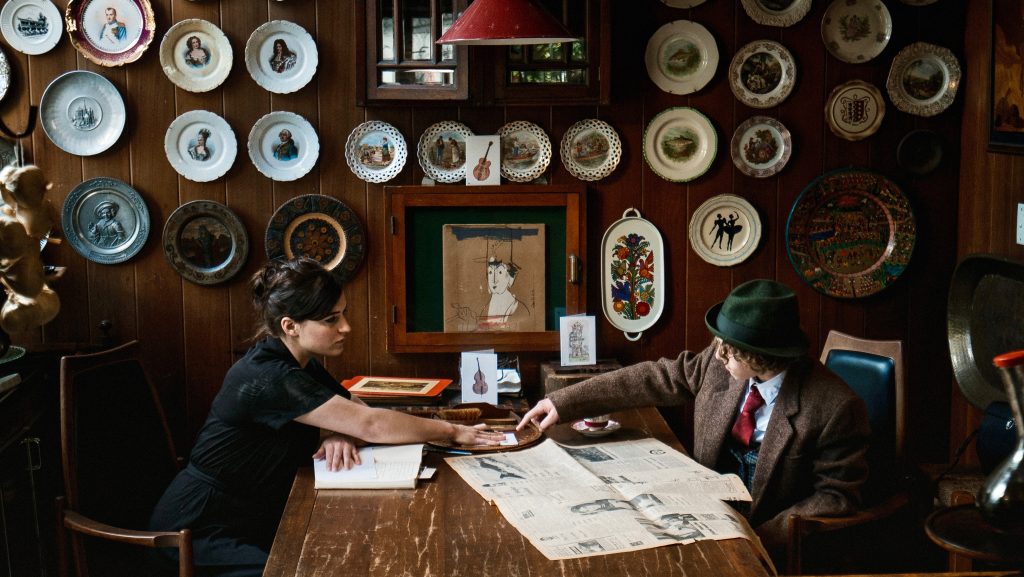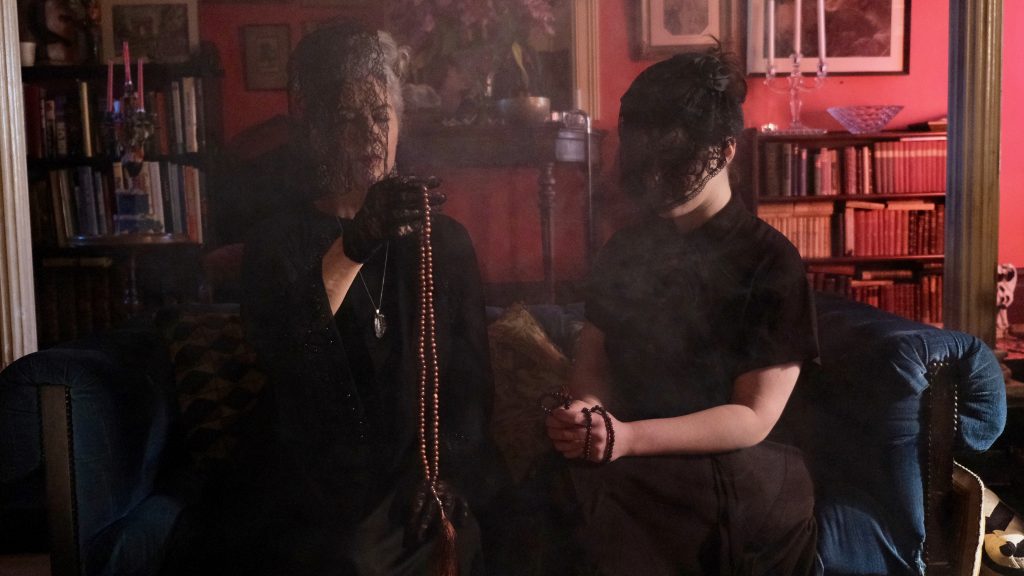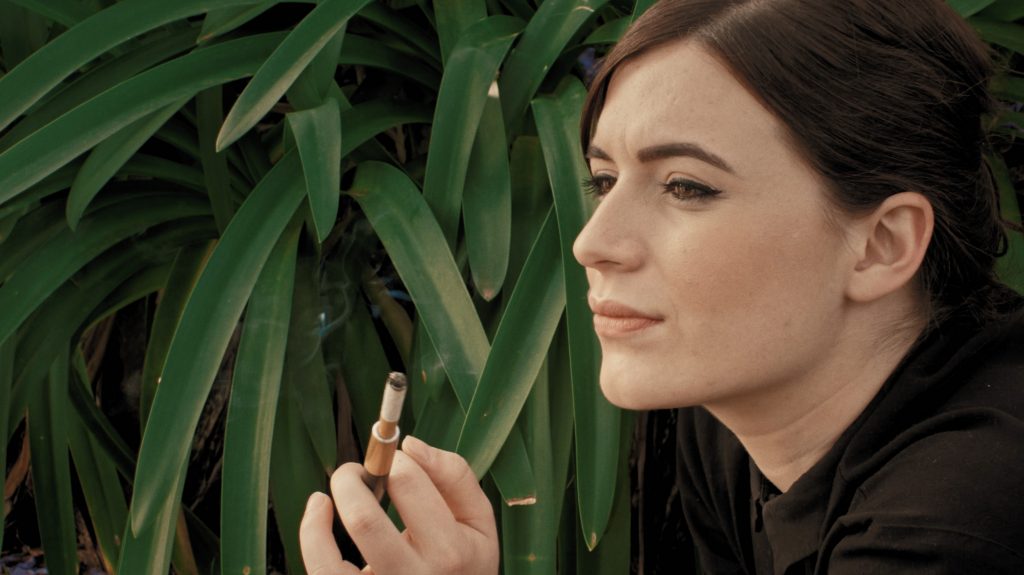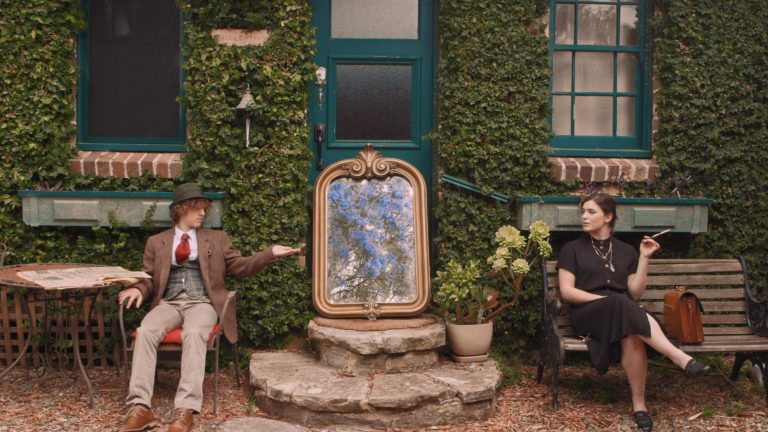Le Miroir is a visual delight of a short film, one that shows a talented director on the rise. In celebration of the news that Le Miroir will be screening at Western Australia’s grand Cinefest Oz festival, we put some questions to director Leila Murton Poole about how she went about making this delightful short film.
Where did the inspiration for Le Miroir come from?
The idea for Le Miroir came from an image of a woman carrying a mirror down a street and features in Tarkovsky’s The Mirror (although I didn’t know this at the time!). The image was given to me by my mentor as an idea prompt for my thesis project at Sydney Film School. I was also very inspired by an Iranian rock band called Kiosk and specifically one song called Charkhesh E Pooch – I love the traditional folk style and although it has a ‘fun’ carnival vibe, there is a real sadness at its core. I referenced this throughout to inform the tone of the film. The song actually features in the soundtrack of A Girl Walks Home Alone at Night directed by Ana Lily Amirpour. As a director, she is a big inspiration in how she translates her unique creativity into her work.

Despite the obvious comparisons, I have to admit that I hadn’t watched Amelie before writing the film! However, I do love the elements of magical realism that Jean-Pierre Jeunet brings to his films and I’m sure this influenced my direction. Finally, Wes Anderson and how he constructs the image is hugely inspirational. I would never try to emulate this exactly but his films certainly helped guide the set/production design as well as the cinematography and camera movement. I really admire the structure of his work and the incredible architecture he often features. I also have an interest in buildings, likely from being raised by an architect, and have an unusual habit of scanning Airbnb and creating a list of places I would love to film in! The fairy tale cottage in Le Miroir was one of my Airbnb finds and inspired that section of the story which I found long before writing the script.
What has your creative journey been as a filmmaker?
I have a Bachelor’s degree in Economics and Physics and a Masters in Management which is pretty diverse as I’ve always been someone who can’t decide what to do! After graduating, I started working in Finance in London and watched a lot of theatre after work, so much so that I wrote reviews for shows. This then extended into film and I attained a press pass for the London Film Festival and never really looked back. However, I soon realised that I’d like to be making as well as watching them! I quit my job and enrolled on a short documentary course which ignited a passion to not only tell stories but to find them. Film really can be a mix of everything and so it seemed like a great fit for me.
Soon after, I set off on a journey from London to Sydney without flying (so a lot of trains, buses, boats etc.) and was really inspired by what I experienced; how language really isn’t necessary to communicate although admittedly helpful at times! Film is a medium which can transcend traditional communication methods which I’m really interested in. I think this is also a reason that I’m really drawn to the visual and design side of film – good dialogue is great but the emotion comes from beyond the words. Mathilde in Le Miroir is mute after all! In the middle of the Indian ocean, on a boat from Singapore to Perth, I decided I wanted to explore filmmaking more formally and enrolled at Sydney Film School which has taken me up to where I am today.
This is a joyful short about luck, both good and bad. What moments of luck have inspired you in your life?
Luck, as a concept, is an extremely interesting one and there are a huge number of valid interpretations. To name a few, it can be something which happens to a person beyond their control, that which occurs because of the rules of probability or the more superstitious notion concerning one’s fortune. Personally, I take a more scientific view (possibly from my Physics background) of determinism or cause-and-effect; think the butterfly effect and sliding doors with every action having a consequence. This idea is also weaved into Le Miroir.
I realise that I haven’t answered the question … can I say I don’t believe in luck having written this film? I believe there is such a thing as being in the right place at the right time. I think luck is also something that can only be recognised with the benefit of hindsight; something which seems unlucky at the time can open up other opportunities. For example, I wasn’t best pleased to be ‘stuck’ in New Zealand when the coronavirus situation unfolded but now it seems pretty lucky…
The cast is simply wonderful, with all giving great performances. How did you go about casting this short?
I had very distinct characters in mind for each role and it was very ‘lucky’ that they all walked through the door! The process was quite standard in terms of a series of auditions – I put out casting ads and contacted a few people directly, or through their agents, who I thought would suit the roles.
For the lead, I’d seen Rachel Giddens in a short by Sydney Film School the previous year which showed how amazing she is at non-verbal acting and I could really visualise her as Mathilde. She came in for a couple of auditions and this confirmed my suspicions that she was the one!
I knew Tobias would require a certain maturity for a young actor and was confident that Noah Wiseman could bring this to the role as I was familiar with his incredible performance in The Babadook. I contacted his agent to arrange an audition and he brought the awareness and sophistication necessary for Tobias. A chemistry test with both Rachel and Noah then confirmed that they were the perfect duo!
I found Vivienne Powell through her agent as she looked exactly how I envisaged Madame B and had an incredible resume. I have to admit to only holding one audition for Madame B as Vivienne was perfect! The fact she could also sing so beautifully actually meant that I re-wrote the script to incorporate the opera that she sings in front of the mirror and, for me, this is one of the dramatic highlights of the film.
Believe it or not, Michael Caton’s agent actually put him forward in response to a casting advert for the narrator. Safe to say that I did not need to hold an audition! Fortunately, he liked the script and his superb voice brought the film together in a way that so few can.
The cast were simply wonderful to work with and all brought their own ideas to the table about their characters which I love and fully encourage as a director.

What kind of challenges did you face creating a distinctly European film in Australia?
From the start, I never wanted to force the European element onto the film. When you have to try too hard at something, it usually means it won’t work. However, I had specific locations in mind before I even wrote the script which fit the European aesthetic. Originally, we were thinking of building a set for the house but then our production designer (Ziggy Taylor) came across the perfect house on Airbnb which really completed the look of the film.
The one element that I didn’t want to compromise was Mathilde being French and having the accent. This was more of a challenge as I couldn’t find too many actresses in Sydney who were able/willing to do a French accent. Luckily, we had a French sound assistant who also became the accent coach (Estelle Brision) who helped Rachel to perfect hers! Rachel has an Italian background which really helped. The young actress who played mini-Mathilde (Audrey Nitschke) was actually bi-lingual which was ideal!
There is an amazing level of creativity here for a film made on a microbudget. What did you learn as a filmmaker from making Le Miroir?
Aim as high as possible! Take your budget as a creative challenge, not a limiting factor. There are an incredible number of amazingly talented people willing to put their time into creative work if they can see the potential of the project. Having a really good script is hugely important as this engages people’s interest in the project. In the first instance, this is all there is to judge a film on especially when attracting talent.
Take the time to talk to the people who are going to be involved in the project however small a part they will play in the overall picture. If money is tight, be clear on what you can offer them non-monetarily whether it be credits, photographs/stills of their location, a copy of the film etc. Often people are more than happy and excited to be involved in a film project so long as they can also see the benefits. You’ll be really surprised as to how many people will say yes if you ask.
Explore the world creatively and look for opportunity everywhere. For example, I came across our illustrator (Stephanie Gray from Erlenmeyer) at the Rocks markets before I knew exactly how we could use her work but her drawings really fitted the whimsical feel of the film. She so generously let us use her illustrations which decorate the set and the chapter titles.
Finally, accept that not everything will go to plan and that the twists and turns are all a part of the journey!
The cinematography, set design, production design, make-up, and the soundscape of the film, all work together so perfectly. Can you talk about each of these and the collaborative process with your creative team?
The majority of the crew were on the same course at Sydney Film School and so we would see each other every day and talk about our projects which really enhanced the collaborative process. This meant that everyone fully understood the creative vision as they were involved from the inception of the idea to the completion of the project.
The cinematography was so important for the picture-book story style that we wanted to achieve. Once we had established the basics to best present this (wide lens, deep focus, mainly static shots), myself and the DOP, Byron Luckey, visited the locations multiple times to map out the shots. This was a formalist style film and there were technical shots which needed to be planned out in the exact locations to check that they would work. For example, the whip pans and tracking shots moving through the rooms of the house, not to mention filming with a mirror! The framing was also key for the tableau shots and required a great deal of precision. Byron is also a trained actor and so has a great eye on how to effectively capture performance which is always a real asset on set.
The set and production design is a huge part of the film and was expertly handled by Ziggy Taylor and Ellen Doolan. From making paper cranes, to throwing a ‘cat’ out a window and finding a tricycle and trailer to carry both actors and the mirror through Australian bush really is no easy feat and we had many hours of meetings and discussions. The mirror was one of the most important and difficult props. It had to be wide enough to fit both actresses’ reflections, not too big/heavy so that it could be carried by the talent, be both broken and fixed interchangeably depending on which scene we were filming and look magical! I think we looked at hundreds of mirrors. In the end, we found the final prop at the back of a small antique/second-hand shop. The frame was actually made of plastic (so not too heavy or expensive) and we had it scenic painted to look gold and more antique. We then had a double-sided glass pane made – one side which was broken and one which was not so it could be switched around when necessary. The design and camera team worked closely together to showcase the necessary story elements in the best possible way whilst maintaining the style of the film.

The makeup was managed so beautifully by Dee O’Keefe who really needed little direction after we had discussed references and each look. Make-up was so important, particularly for Mathilde and Madame B and, after reading the script, she really understood the European feel of the film and how to achieve this with their hair and make-up – they were both works of art! She is a perfectionist which is exactly what I was looking for and her attention to detail is incredible.
Music was integral to the film and I knew that I needed a great composer. However, I never expected it to be Guy Gross! I sent a speculative email with no expectations, but he was really enthusiastic about the film and worked to a ridiculously tight deadline to produce the most amazing score. As I mentioned, music was one of the first things that had inspired the whole idea and tone of the film and so to have an original score recorded with live instruments really is a dream come true. I am forever grateful to him for taking it on! The original score was also just nominated for a crystal pine award at the prestigious International Sound and Film Music Awards which is a testament to his work. I also have to mention the sound mixers (Liam Moses and Anthony Marsh) and designers (Liam Moses and Nathaniel Watkins) who further built the soundscape and helped to finalise the magic.
What has your work with the Sydney Film School been like?
I really enjoyed my time at Sydney Film School. I was involved in over 15 shorts in various different roles and it gave a great overview of the entire filmmaking process so that you can then decide what areas you’d like to focus on. It was also extremely practical and you are involved in making high quality shorts from the start. The community was amazing; I have made lifelong friends amongst both students and staff and I hope to work with them again in the future.
With your first short film now completed, what would you like to achieve and tackle as a filmmaker?
Firstly, I’m excited to take Le Miroir on its festival journey. I’m thrilled to announce that our world premiere will be at CinefestOz which is the perfect festival for our French-Australian film.
For anyone in WA, tickets can be bought at via the Cinefest website. We are screening as part of the Borderless Shorts Film Set on 25th August at the Margaret River Heart and on 26th August at the Busselton Esplanade Hotel. It will also be available via an online screening for national audiences.
Moving forward, I’d love to move into features. I have thought of Le Miroir as a proof-of-concept short as I can also see this working as a longer piece. Lockdown was a blessing in disguise as it meant that I could focus on writing which I really enjoy – I have a few ideas that I’m developing so watch this space!
Make sure to follow Le Miroir on their social media accounts too:
Website: https://www.lemiroirfilm.com/
Facebook: https://www.facebook.com/lemiroirshortfilm
Instagram: https://www.instagram.com/lemiroirfilm/
Twitter: https://twitter.com/LeMiroirFilm




